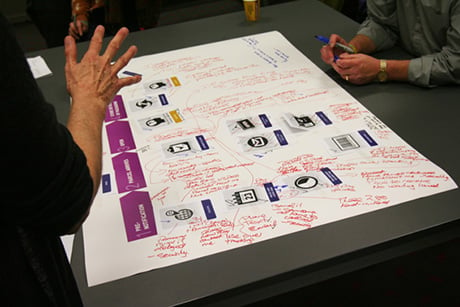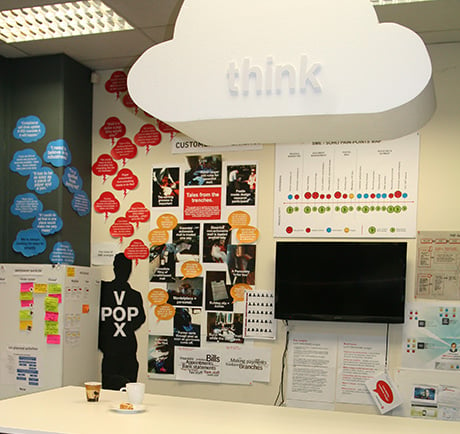The business of design: David Boyd, NZ Post

Today sees the publication of the first in a series of interviews we're conducting with designers and design-minded individuals plying their trade in senior roles within organisations. We are collecting the interviews under the title of "The Business of Design".
These interviews are intended to provide insights into the challenges faced by those at the vanguard of introducing design approaches within businesses, the successes they've had and the advice they'd give to others in similar environments.
 The first interview is with David Boyd, Head of Experience Design for New Zealand Post.
The first interview is with David Boyd, Head of Experience Design for New Zealand Post.
Around the world postal services are experiencing significant challenges to their existing business models brought on by the digital times in which we live.
In the interview, David talks about his experience establishing customer-led design processes at New Zealand Post. He reflects on the challenges he has faced, the lessons they've learned and the successes they've experienced.
I will try not to get too much in the way of David expressing himself in his own words, but four soundbites in particular stood out for me:
- "We learned that if you demonstrate value by doing and you genuinely facilitate the wider business’s involvement in this, you will be much more effective."
- "The nirvana state is that NZ Post won’t need an experience design team. The way we work just becomes part of business as usual."
- "Most people don’t disagree with the concept of being customer-led. They understand it in theory, but when they have the pressure of getting a business case out pronto they can still default to the old ways."
- "working inside business you need to park some of the academic language"
Tell me a bit about your role at New Zealand Post and the types of things you’re applying your design skills to?
I am Head of Experience Design at New Zealand Post. It is a new capability for the organisation. Over the last year we’ve clarified that our role is to facilitate the customer-led design of our products and services – the key word here is ‘facilitate’. I lead a team of six, including myself. The team has two strategists who lead and facilitate large projects, a project manager, a service designer and an information designer. It is a good mix.
We work across channels, business strategies, and product and service development. Within that, our work covers everything from design insight, strategy and solution design, through to helping people visually articulate concepts. We find that visualising ideas is a really valuable way to get a message across in a large corporate environment and its also a good way to introduce people to design thinking.
Do you have a strong advocate within the business? Are people mandated to engage your team?
Work doesn’t come to us by mandate. We have a strong advocate in our General Manager, who is the General Manager of Customer Experience, which includes marketing, segment management, channels and experience design. The team is a healthy mixture of ‘orthodox’ marketing and ‘unorthodox’ design-thinking. We’ve worked together over four years (in a previous branch of the business) to build this thing, thanks to the support of our executive manager, who instinctively gets the value of working with customers to design solutions.
For us it has always been about proving value rather than mandating
involvement. We have been given the luxury of time to prove this value because our sponsor understands the value we deliver. But beyond this immediate support, it is fair to say there wasn’t much understanding of what we do when we arrived at NZ Post a year ago. We were a bit of an island. When we started we quickly realised the more you behave like you have a mandate the less you engage with people. We learned that if you demonstrate value by doing and you genuinely facilitate the wider business’s involvement in this, you will be much more effective.
How does the organisation measure the value of what you’re doing? NPS?
There is nothing at the moment, but we are working on it as part of a suite of measurements for the Customer Experience team. The current measure is the clear value, in terms of insight, we have added in the past year to product development projects.
Do you have any particular success stories you can share with us?
There have been a number of what I call proof points. The first engagement at NZ Post was on a digital substitute for physical mail. We got involved in something that had already got a fair way down the track as a traditional product-centric project. Working with an outside agency we carried out ethnographic research and developed a number of customer-led design principles and concepts.
We identified the fact that customers had no problem with the delivery of mail and, in doing so, turned the project around from one that was about mail delivery, to one that was about it was the actioning of mail. By actioning mail I mean undertaking the transaction the letter requests – such as paying a bill, completing an application, etc. The focus of Post has historically been up to the letterbox, but not beyond. By becoming engaged in 'actioning' NZ Post can effectively expand its activity and market, as well as build a relationship with customers by facilitating the data exchange.
So you redefined the problem?
Yes. We redefined the problem and reset the organisation’s expectation of the digital channel. We discovered that paper remained the default and that digital services would have to work hard to be an easier alternative and change this. Over time the concept of ‘actioning mail’ caught on within the company. Initially people didn’t seem to get it. In hindsight, I realised we had tried to change people’s thinking in an evangelistic way, but we then realised that if you’ve got a fantastic idea you’ve got to let other people own it and effect change that way.
Do you get to a point where you are forced to walk away from a project, or can you maintain involvement in the long tail of the project coming to fruition?
Maintaining involvement is something we’re still working through. We still tend to hand over our design insights and concepts to product teams and they do with them what they will. One advantage is that I am well positioned in the organisational structure to be able to influence how the insight is implemented. I can work with my management peers to make sure concepts stay on track.
Which aspects of design or customer-centricity have been easiest to instill within the organisation?
The easiest thing is that through involvement people really get the idea of deep-dive behavioural insight. Problems can occur when you get too mixed up with trying to describe it and position it, but when people actually experience it – when they see a well-facilitated customer co-creation session they get it – they get that it feels different and that the results are different. One of the most powerful things that we’ve ever done is to get people from the business to participate in customer co-creation sessions. It really opens people’s minds up. They talk about the anecdotes. It really engages people in ideas.
The experience of seeing customer-centred design in action is a big thing isn’t it? People get it pretty quickly don’t they – your biggest skeptics very quickly become your biggest advocates.
Yes. Sometimes it almost feels too simple. You think “See, you could do this yourself”. Anyone can go up and talk to a customer.
And, anything that has proved difficult to instill within the company?
I work in a business that is experiencing a rapid decline in the relevance of its core offer, so there is a real need for speed. There is a call to rationalise our existing business, find relevant new products and services, and a commitment to do it all in three years. That creates an intense level of speed. Because our design process takes time up front, we see product people start on their business requirements process and get a long way down the track before we’re engaged. Sometimes that causes a problem. What the customers need and what the business is doing doesn’t necessarily mesh. And you can end up with more compromise than there should be.
So the ideas of the business become a bit more concrete than ideally they would be?
Yes. There are an army of BAs in this business. And the traditional project model is that as soon as anyone has a good idea there is a project manager and a BA engaged first up. They are a valuable input, but in isolation they look at the needs from a particular lens and can struggle with getting the right customer requirements right. They can spend days mapping out customer interactions – something that could be done with a ‘live’ customer in half a day. It is changing. I have invested a lot of time in developing a solution design process for the business. It clearly articulates a customer-led evaluation process and how it works with business requirements, to inform the business case and product implementation.
That sounds like a tool that will also help spread the word beyond your immediate involvement in projects?
Absolutely. The nirvana state is that NZ Post won’t need an experience design team. The way we work just becomes part of business as usual. It is a challenge, but we’re making surprisingly good progress. Most people don’t disagree with the concept of being customer-led. They understand it in theory, but when they have the pressure of getting a business case out pronto they can still default to the old ways. Our job is to sell the value in terms of improved innovation, project efficiency and uptake in the end, with just a little more investment in working with the customer up-front.
Can you recommend what someone aspiring to make design work in a business should do, read or watch?
Just prove the value at every opportunity. Apply design thinking wherever you can. That sounds a bit simplistic, but we went through a phase here where we were evangalists and we received a lot of passive resistance – “Nice idea, but don’t know how to apply it here”. As soon as you genuinely start applying it in the business and collaborating with people it is very different. We’ve realised genuine collaboration is the essential part of design thinking. By doing this we’ve really accelerated our progress over the last year.
The other thing I’ve realised is that when working inside business you need to park some of the academic language. You may be getting people involved in a customer co-creation workshop, but you don’t have to call it a customer co-creation workshop – you can just say we have some customers in and why don’t you sit down with them and find out what they want. They’ll quickly get the idea. Practitioners risk being far too academic. I frequently meet people who are obsessed with the ‘correct’ terminology – endlessly debating whether they are experience designers or service designers – it seems like a waste of valuable energy to me that could be diverted into demonstrating value. Within a large business you need to be adaptable to affect a change.
This interview was conducted by Iain Barker. If you would be interested to be interviewed as part of the business of design series, please contact iain@meldstudios.com.au.
Images courtesy of David Boyd.


